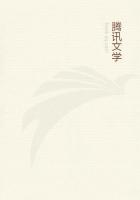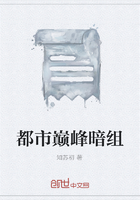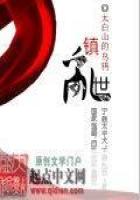their first essay.It forms their constant recreation.They afterwards heave at each other with pointed twigs.He who acts on the defensive holds a piece of new soft bark in the left hand,to represent a shield,in which he receives the darts of the assailant,the points sticking in it.Now commences his turn.He extracts the twigs and darts them back at the first thrower,who catches them similarly.In warding off the spear they never present their front,but always turn their side,their head at the same time just clear of the shield,to watch the flight of the weapon;
and the body covered.If a spear drop from them when thus engaged,they do not stoop to pick it up,but hook it between the toes and so lift it until it meet the hand.Thus the eye is never diverted from its object,the foe.If they wish to break a spear or any wooden substance,they lay it not across the thigh or the body,but upon the head,and press down the ends until it snap.Their shields are of two sorts.That called 'illemon'is nothing but a piece of bark with a handle fixed in the inside of it.
The other,dug out of solid wood,is called 'aragoon',and is made as follows,with great labour.On the bark of a tree they mark the size of the shield,then dig the outline as deep as possible in the wood with hatchets,and lastly flake it off as thick as they can,by driving in wedges.
The sword is a large heavy piece of wood,shaped like a sabre,and capable of inflicting a mortal wound.In using it they do not strike with the convex side,but with the concave one,and strive to hook in their antagonists so as to have them under their blows.The fishing-lines are made of the bark of a shrub.The women roll shreds of this on the inside of the thigh,so as to twist it together,carefully inserting the ends of every fresh piece into the last made.They are not as strong as lines of equal size formed of hemp.The fish-hooks are chopped with a stone out of a particular shell,and afterwards rubbed until they become smooth.They are very much curved,and not barbed.Considering the quickness with which they are finished,the excellence of the work,if it be inspected,is admirable.In all these manufactures the sole of the foot is used both by men and women as a work-board.They chop a piece of wood,or aught else upon it,even with an iron tool,without hurting themselves.
It is indeed nearly as hard as the hoof of an ox.
Their method of procuring fire is this.They take a reed and shave one side of the surface flat.In this they make a small incision to reach the pith,and introducing a stick,purposely blunted at the end,into it,turn it round between the hands (as chocolate is milled)as swiftly as possible,until flame be produced.As this operation is not only laborious,but the effect tedious,they frequently relieve each other at the exercise.
And to avoid being often reduced to the necessity of putting it in practice,they always,if possible,carry a lighted stick with them,whether in their canoes or moving from place to place on land.
Their treatment of wounds must not be omitted.A doctor is,with them,a person of importance and esteem,but his province seems rather to charm away occult diseases than to act the surgeon's part,which,as a subordinate science,is exercised indiscriminately.Their excellent habit of body,the effect of drinking water only,speedily heals wounds without an exterior application which with us would take weeks or months to close.
They are,nevertheless,sadly tormented by a cutaneous eruption,but we never found it contagious.After receiving a contusion,if the part swell they fasten a ligature very tightly above it,so as to stop all circulation.Whether to this application,or to their undebauched habit,it be attributable,I know not,but it is certain that a disabled limb among them is rarely seen,although violent inflammations from bruises,which in us would bring on a gangrene,daily happen.If they get burned,either from rolling into the fire when asleep,or from the flame catching the grass on which they lie (both of which are common accidents)they cover the part with a thin paste of kneaded clay,which excludes the air and adheres to the wound until it be cured,and the eschar falls off.
[Their native hardiness of constitution is great.I saw a woman on the day she was brought to bed,carry her new-born infant from Botany Bay to Port Jackson,a distance of six miles,and afterwards light a fire and dress fish.]
Their form of government,and the detail of domestic life,yet remain untold.
The former cannot occupy much space.Without distinctions of rank,except those which youth and vigour confer,theirs is strictly a system of 'equality'attended with only one inconvenience--the strong triumph over the weak.Whether any laws exist among them for the punishment of offences committed against society;or whether the injured party in all cases seeks for relief in private revenge,I will not positively affirm;
though I am strongly inclined to believe that only the latter method prevails.
I have already said that they are divided into tribes;but what constitutes the right of being enrolled in a tribe,or where exclusion begins and ends,I am ignorant.The tribe of Cameragal is of all the most numerous and powerful.Their superiority probably arose from possessing the best fishing ground,and perhaps from their having suffered less from the ravages of the smallpox.
In the domestic detail there may be novelty,but variety is unattainable.
One day must be very like another in the life of a savage.Summoned by the calls of hunger and the returning light,he starts from his beloved indolence,and snatching up the remaining brand of his fire,hastens with his wife to the strand to commence their daily task.In general the canoe is assigned to her,into which she puts the fire and pushes off into deep water,to fish with hook and line,this being the province of the women.If she have a child at the breast,she takes it with her.

